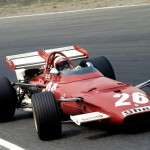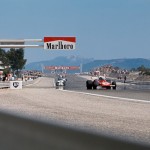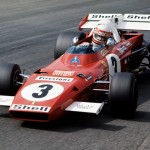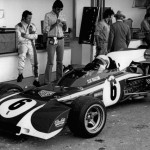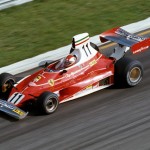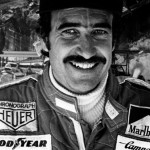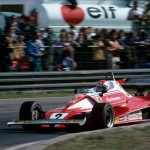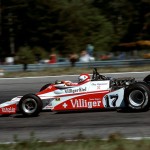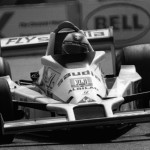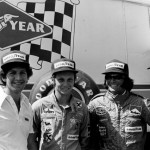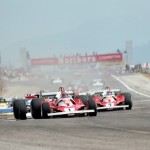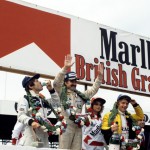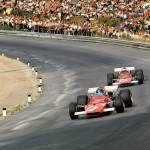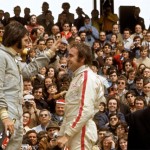Clay Regazzoni: The man who could never stop
Throw anything that life could at him, but Clay Regazzoni still raced whatever he could get his hands on. Even after he was paralysed.
Clay Regazzoni is one of those drivers that seemingly would have fitted in any racing decade from the 1950s onwards.
You can picture the suave-acting, stereotype racer, as he battled with Mike Hawthorn or Sir Stirling Moss, or Jim Clark – and especially Graham Hill – just as well as he fitted in with his personal era in Formula 1 in the 1970s. They were gentlemen all.
In true swash-buckling style of racers in the 1960s and 70s, Clay tried his hand at all sorts. Name any classic event, and he had a go! In 1970, his first year in F1 (making his debut in a Ferrari, something which only a handful of drivers have done), he also shared a Ferrari F12S at Le Mans for the 24 Hours with Arturo Mezario. The car barely made darkness, but he remained racing sportscars for Ferrari, taking second place at Brands Hatch in 1000kms with Jacky Ickx. The pair also won at Monza’s 1000km too – a circuit that, with racing banned in Switzerland, became Reggazoni’s spiritual home.
It’s F1 that most people associate him with though, a career that started in 1970 with a win in his debut season at (where else?) Monza, and sadly ended in 1980 with a very nasty crash at Long Beach that left him paralysed from the waist down.
In between the bookends, he drove for Ferrari, twice, BRM, Ensign, twice, Shadow and Williams. A line graph of his career looks more like a map of a Tour de France mountain stage, as erratic as it was with peaks and troughs throughout his 10 years.
The 1974 championship was the one where Clay came closest to winning the world title. A season-long battle between him, his Ferrari teammate Niki Lauda, McLaren’s Emerson Fittipaldi, and Tyrrell’s Jody Scheckter went to North America for the final two races all four of them with a good chance of winning the title. The Canadian GP at Mosport put paid to Lauda’s chances when he spun out, leaving Reggazoni and Fittipaldi tied on points in the lead, and Scheckter in the running, but needing a huge dose of luck at the final round at Watkins Glen in the American Grand Prix.
The South African qualified sixth, Fittipaldi eighth, and Regazzoni ninth after all three suffered problems. In the end the race was a damp squip. Regazzoni had suspension problems that sent him slipping away to what would be an eventual 11th place, Scheckter retired eight laps from the finish with a fuel pump/pipe problem. The title was Fittipaldi’s.
After that season, ‘Regga’ won once in 1975 – at Monza again to delight the tifosi, but by then Ferrari was Niki Lauda’s team. His final Ferrari win came at Long Beach in 1976.
For 1977 he joined Ensign, and in 1978 moved to Shadow. His best championship position in that time was 16th, far from the heady Ferrari days.
Clay moved again in 1979 as Williams expanded to two-cars. The team had yet to win a race, so it looked as though his F1 downward career spiral may continue, and let’s face it Clay was 39 years old by then.
It couldn’t have been further from the truth. Frank Williams had funding, Patrick Head designed a simple and competitive car in the FW07. Against all the odds, it was not Alan Jones that won the team’s first Grand Prix, it was Clay, at Silverstone in the British Grand Prix – a fact even he found hard to believe.
“I haven’t deserved anything,” he said after the race. “It’s the car you have to congratulate, the designer Patrick Head who drew it, and Frank Williams who runs it… it’s the car, not me.”
Humble as the Swiss driver may have been, after his career with Ferrari, there was one moment during the racing at Silverstone that brought a smile to his face. The world championship leader, and one of Clay’s title rivals Jody Scheckter in 1974, was on his way to the 1979 world championship. “I was surprised to see a Ferrari in front of me as I led, but when I lapped him coming out of Copse, I thought of the Commendatore [Enzo Ferrari] down in Maranello, watching on TV…”
The British GP win was Williams’ first, and Clay’s final. But he wasn’t about to stop yet.
For 1980, he returned to Ensign. Hopes weren’t high, but Clay was racing and that’s all that mattered. By round four progress was being made, but perhaps in one of the ultimate ironies, he started that race on the final row of the grid. In last place was the guy he fought for the 1974 title – Emerson Fittipaldi. Who would ever have thought that these two would be the last two qualifiers?
Regazzoni’s pace was quick, and within 16 laps, he was up to ninth place. By lap 50 he was an amazing fourth, with Emerson in his wheel tracks in fifth. That’s when it all went wrong. At around 175mph at the end of Shoreline drive, he suffered brake failure. He tried his best to slow down by aiming at Ricardo Zunino’s abandoned Brabham. It scrubbed off 25mph, but the final impact with the wall was still huge. Emerson, was shocked – as was anyone who saw it.
“I was behind him and saw he lost his brakes,” remembers Fittipaldi. “I could see he was trying to spin the car to slow it down, but at that speed, there was nothing he could do.
“When I turned into the hairpin,” the Brazilian added, “I lost sight of him, but I heard an enormous crash.”
As the rescue workers attended to the injured Regazzoni, the race continued. Not many drivers would admit to the next comment Emerson made. “The crash really affected me for a couple of laps,” he said. “It was dreadful, my legs were trembling, and I don’t think John Watson who was behind me could either. He slowed down as well.”
When news came through after the race that Clay had survived, there was relief, tinged with the fact that his back had been broken. “Only a miracle allows one to come out of an accident like that alive,” said Emerson.
After months and years of spinal rehab, it was clear his racing gene was 100% intact. Not only did Regazzoni start racing again in karts, he helped other disabled people. He also returned to his sportscar roots to compete in the Sebring 12hrs, and possibly the most gruelling event in the world, the Paris-Dakar Rally. He closed his personal book on Long Beach too, where he had experienced the ultimate high and ultimate low, by racing in the Toyota Pro/Celebrity race in 1994 – as a Pro.
Sadly, after all that he had been through, Clay Regazoni lost his life in a road accident in Italy in December 2006. It was the end of an era.
Special thanks to the Cahier Archive for the photos, and Toyota Motorsport for background information.
By Andy Hallbery follow me on Twitter @hallbean
Follow @MotorSportRetro on Twitter
Like us on Facebook


